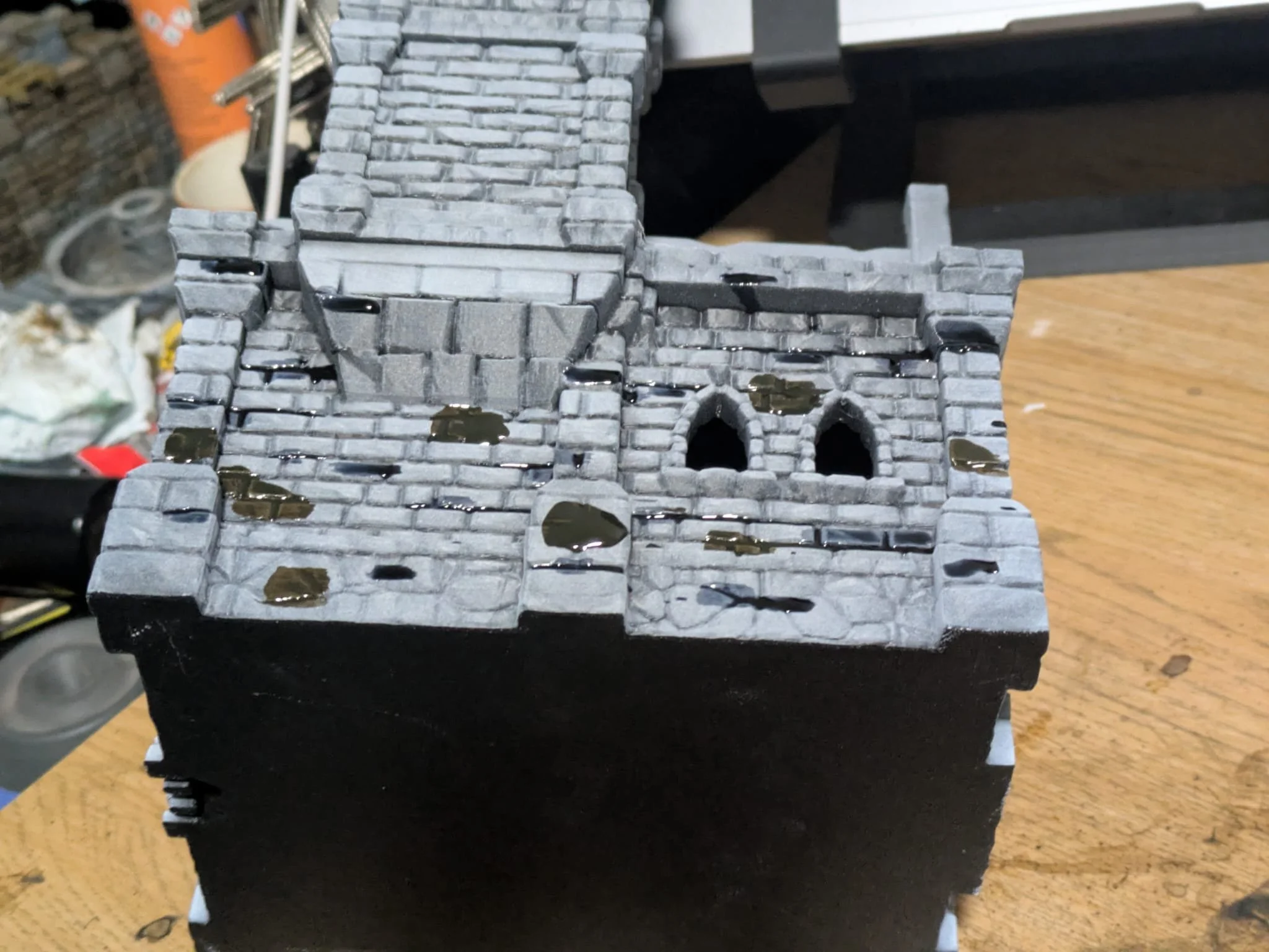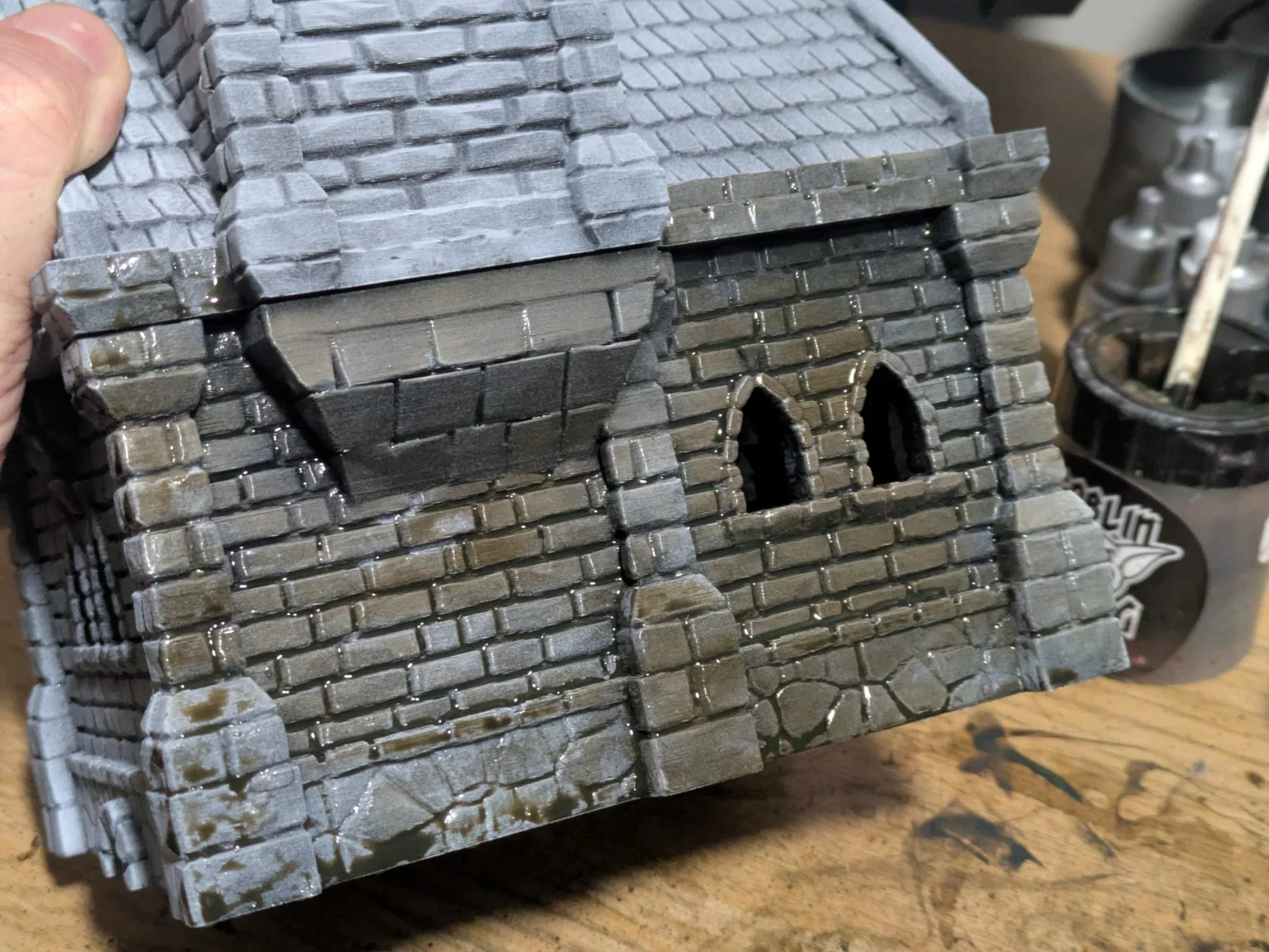What’s The Story, Muthur?
To the point, tabletop gaming
Nemesis Retaliation: Single Play, First Thoughts
Tactics don’t carry over, and that’s for the best. I didn’t want a reskinned Nemesis. I wanted something that pushes you into new patterns of play, and the game delivers.
By JimmiWazEre
Opinionated tabletop gaming chap
TL;DR:
Nemesis Retaliation isn’t simply more Nemesis. It shifts the game from slow, sneaky survival horror to squad-based pressure and firefights, with new mechanics that punish old habits. After one co-op play (and a total wipe), it’s clear this earns its place alongside the original rather than replacing it.
Disclaimer
This article contains affiliate links to the first and second games in the Nemesis series. As far as I am aware, Nemesis Retaliation is not yet available to buy in the shops, and I got mine through the crowdfunder. If you use the affiliate links, I’ll get a small kickback at no additional cost to you.
Introduction
This isn’t a review or anything, but I finally got around to playing my crowdfunded copy of Nemesis Retaliation the other weekend and I wanted to share my thoughts. Fans of the blog will know I’m a huge fan of Alien, and games like Nemesis are an absolute given for me.
I’ve seen some mixed reviews online about Retaliation though, so I wanted to add my own thoughts into the mix.

Background & Expectations
I’m a veteran of the original Nemesis and it’s up there with Eclipse 2nd Edition as one of my favourite big-box games to bring out on game nights, however I never bothered with the second game: Nemesis Lockdown. Everything I’d heard suggested it was more of an iteration upon the original, but not enough to feel like a truly distinct experience. Therefore I’d concluded that if you had a choice between Lockdown or the original, to get Lockdown. But if you’d already got the original, then to just stick with that.
The third game in the series; Retaliation was different. As soon as I saw the campaign and realised its intent to do for Nemesis what Aliens did for Alien - my pickle was tickled. I wanted that sweet new flavour built on the same core foundations.
Happily, that’s exactly what it delivers.
Player Count & Setup
Our planned five-player session collapsed into two-player after some last-minute cancellations, but that actually worked in our favour. It let us soften the difficulty a bit while learning the system and gave us space to experiment without the pressure of a full table.
Like the original game, Retaliation comes with a fully co-op mode which allows the game to be enjoyed with low player counts. It’s a great way to get introduced to it.
How is it Different?
Mechanics
The mechanics feel familiar, but only up to a point. Enough has changed that assumptions from the original will trip you up. This happened frequently, and it’s really something to watch out for.
Noise rolls, for example, are handled differently. They’re close enough to feel recognisable but different enough that I’ll need a few more plays before they become intuitive rather than something my old habits keep fighting.
Numbers on the back of Intruder tokens don’t represent something you have to beat with your cards in hand anymore, instead referring to the amount of that type of intruders that drop into play.
The variable health of intruders is now dictated by dice roll instead of card draws.
Vibes
Tactics don’t carry over, and that’s for the best. I didn’t want a reskinned Nemesis. I wanted something that pushes you into new patterns of play, and the game delivers.
Retaliation is far more about being overrun. Intruders appear quickly and in numbers, and the game seems to expect players to operate as a military squad, and captures that quite nicely, encouraging you to:
Clear threats early
Maintain control of corridors
Shore up rooms and corridors to prevent a cascade of trouble
In contrast to the original’s emphasis on careful movement and sneaking around in small groups, this is much closer to a tactical firefight.
That doesn’t mean it’s without the creeping dread though - the new oxygen mechanic is a ticking time bomb that will suffocate you, if only you had a chance to take a minute from opening fire to swap out your air tank…
Our Outcome
We didn’t know better and we were testing the waters, so we didn’t play it the way the game wanted us to. We split up, ignored securing the map, and got swarmed. By about turn 10 we were out of ammo, the board was overflowing with intruders, and we ended in a wipe. Poor Chris had been single-handedly trying to hold back the Queen for the last three turns when his magazine finally clicked empty for the last time.
I’m not put out by this though. Quite the opposite in fact. That failure made it clear just how differently the game wants you to think and it’s a good sign for justifying its existence alongside the original Nemesis.
Conclusion
I enjoyed my first play of Nemesis Retaliation. Once I’m fully comfortable with the rules and not fumbling through turns, I can see myself liking it even more. After a single game, though, I’m confident that this is exactly the version of Nemesis I hoped it would be.
My next steps for it are going to be getting it on the paint table - my original is fully painted, and everyone enjoys the extra dimension that brings, so I’ve set a precedent now haven’t I?!
Hey, thanks for reading - you’re good people. If you’ve enjoyed this, it’d be great if you could share it on your socials - it really helps me out and costs you nothing! If you’re super into it and want to make sure you catch more of my content, subscribe to my free monthly Mailer of Many Things newsletter - it really makes a huge difference, and helps me keep this thing running! If you’ve still got some time to kill, Perhaps I can persuade you to click through below to another one of my other posts?
Catch you laters, alligators.
5 Cuts To 5e That Make The Game More Interesting
I know I'm gaining a bit of a reputation as someone who doesn't like 5e, but the truth of the matter is that I actually think that there's a very solid game there, it’s just hidden under layers of interdependent ill-considered bloat.
By JimmiWazEre
Opinionated tabletop gaming chap
TL;DR:
5e works best when players feel real pressure on their resources, but several rules quietly remove that tension. Dropping or rewriting things like Darkvision, Goodberry, huge carry limits, arcane focuses, and certain healing tools restores challenge, creativity, and the classic dungeon-crawling feel that the system was built for.
Introduction
Now then! Opinions incoming - you’ve been warned, and you’re allowed to disagree!
I know I'm gaining a bit of a reputation as someone who doesn't like 5e, but the truth of the matter is that I actually think that there's a very solid game there, it’s just hidden under layers of interdependent ill-considered bloat.
The problem isn't just that bloat adds unnecessary complications to a fairly elegant core system, but that unless the designers are willing to kill their darlings, they can end up neutering their own system with their well-intentioned unfettered ideas.
The way I see it, the core gameplay loop for D&D 5e is to repeatedly face the expeditioning party with challenges which cause them to gradually consume their limited resources, bringing them to a weakened state before hitting them with a big challenge.
That limitation is key, as it forces players to make trade offs and use their creativity to find unique ways of accomplishing things - the very facets which define the genre.
The key restrictions that the game places upon players are with inventory, spell slots, hunger, HP, and the Action Economy.
So with that in mind, given my group plays 5e more than anything else: here's the fat that I like to trim from the game to stop it from undermining itself, without unintended consequences to other sub systems:
Darkvision & The Light Cantrip
Darkvision allows a creature to see in dim light as if it were bright light, and in darkness as if it were dim light. A creature with darkvision sees in shades of gray rather than color in darkness and cannot see in magical darkness unless the ability specifies otherwise. The range for darkvision is often 60 feet, but can vary case to case.
The Light cantrip causes a touched object (no larger than 10 feet) to shed bright light in a 20-foot radius and dim light for an additional 20 feet for up to an hour.
Is there a more evocative image of dungeon crawling than a band of adventures cautiously exploring the haunted stone corridors of some long forgotten tomb by torchlight?
The rules for fighting or exploring in the darkness make you so much more vulnerable - imposing disadvantage on checks and attacks, or even preventing them altogether. Obviously it's something to be avoided at all costs.
It is in fact, a great problem for players to solve, so when the game hands them two zero-cost solutions in the form of the light cantrip and darkvision it's seems like the designers have just robbed the players of an interesting challenge to overcome.
Goodberry
The Goodberry spell creates ten magical berries that each restore 1 hit point and provide a day's worth of nourishment when a creature uses its action to eat one.
Whilst in theory we should be grateful that this is not a cantrip, the problem with Goodberry is that players aren't going to be using it for its rubbish health recovery properties - but more as a source of food for the whole party.
For this functionality it is incredibly over powered for the cost of one first level spell slot. All a magic user needs to do is hold one level one spell slot back per game day, which is easily done when hex or point crawling, and then cast Goodberry before bedtime to ensure the party is fed.
If your game involves any amount of wilderness exploration, you can drop any ideas you might have about them hunting and foraging for food, or balancing inventory management with rations. Those game elements are made redundant. Apologies to any Rangers…
Base Carry Capacity & Bag of holding
Your base carrying capacity in lb is your STR score multiplied by 15. The Bag of Holding grants an additional 500 lb and 64 cubic feet of storage.
Near unlimited storage space. This is possibly the worst idea for a magic item in the entire game.
As players, simply spend your vast wealth (that you can carry in near infinite amounts) in town on multiple copies of every possible thing you could ever need, and then sit back in sheer boredom as you proceed to solve every in-game problem by pulling the perfect item out of your extra dimensional bag.
Yawn. Ditch it.
And it’s not like base carry capacity is much better, if we take the basic STR value of 10, that becomes 150 lb of carry capacity, to help you visualise that - it’s nearly 70 bags of sugar. That’s ridiculous, and even more so as you have characters invest in their STR stat above 10.
Not only do I get rid of these rules, I replace them with a much better inventory system lifted from Mausritter.
Arcane focuses
An arcane focus replaces material spell components that do not have a listed gold cost. To cast a spell with a focus, you must hold it in one hand, which can also be used for somatic components.
Spells in D&D have one or more components which are indicated by the acronyms VSM which stand for Verbal, Somatic, and Material. Most spells have material components which in game terms reflects a balancing element - aspiring casters must have the requisite materials on their person in order to cast the spell.
Unfortunately, Arcane Focuses do away with this in most cases - allowing casters to replace the material requirement for items that ‘do not have a cost’ with the possession of a non consumable artefact representing an arcane focus.
That shattering crescendo you hear is the sound of intentionally designed internal character balance being launched through the window.
Honorable Mentions
Healing Word
Like Goodberry before it, the utility of Healing Word is not the amount of HP that it recovers, but rather for the fact that it brings someone back from death saving throws cheaply. Consider the combination of the following three elements:
It can be cast at distance - characters do not need to be adjacent to their target.
It can be cast as a bonus action - characters do not need to make a choice about sacrificing their main attack or restoring their ally.
It’s a level one spell - casters have immediate access to it and as the game progresses with upcasting, have an abundance of slots with which to cast it.
As it is, I keep Healing Word in my games, and as GM I compensate by having vicious or intelligent enemies perform a “double tap”. The first attack takes a character down, and the second performs the coup de gras grâce (Ed. Thanks Dries!). I should mention that I don’t do this because I'm particularly sadistic or competitive (honest!) but rather to keep the game enjoyably challenging.
Fortunately this works for my group, but some people might find it too brutal or even ‘unfair’. In these cases, it might be worth dropping Healing Word instead.
Long Rest
Long Rest restores your character’s HP and Spell Slots to full, and often nullifies the effect of exhaustion effects and some status changes. It’s meant to represent the party recovering inbetween expeditions, however it is unfortunately frequently misused by GMs allowing the party to take a long rest every few encounters - essentially allowing them to approach nearly every challenge with the mindset of going nuclear.
It should be obvious that this undermines the vast majority of resource management, however rather than removing Long Rests from the game entirely, I ensure and introduce the following:
Wandering monster rolls with a high percentage of hitting for when the Players want to take a rest in a place that is teeming with danger - like a dungeon. These interrupt a Long Rest and nullify the benefits.
I house rule that for a Long Rest to provide any benefit, each character must additionally be in possession of a comfortable place to sleep (bed, bedroll, even a pile of hay) and some form of meal. That way, I’ve introduced a resource cost to the act, so even if players get away with a long rest in a dangerous area, it has still cost them valuable inventory space.
Conclusion
Have you considered the impacts of these 5e elements before, and how do you handle them? Let me know in the comments below if you think I’ve missed a trick here.
Additionally, Velocitree has linked their own blog response to my five cuts, which is well worth a read if you want an alternative take!
Hey, thanks for reading - you’re good people. If you’ve enjoyed this, it’d be great if you could share it on your socials - it really helps me out and costs you nothing! If you’re super into it and want to make sure you catch more of my content, subscribe to my free monthly Mailer of Many Things newsletter - it really makes a huge difference, and helps me keep this thing running! If you’ve still got some time to kill, Perhaps I can persuade you to click through below to another one of my other posts?
Catch you laters, alligators.
Cheap Medieval Fantasy Terrain for Tabletop Games
Whether you play TTRPGs or miniature war games, sooner or later you might want some fantasy terrain. This piece is about where I get my terrain from and how I paint it using simple and fast methods.
By JimmiWazEre
Opinionated tabletop gaming chap
TL;DR:
Whether you play TTRPGs or miniature war games, sooner or later you might want some fantasy terrain. This piece is about where I get my terrain from and how I paint it using simple and fast methods.
Disclaimer
Heads up, there’s a few affiliate links in this piece, typically for bits and bobs that I use during the painting process. If you do click on them and then buy from them - I’ll earn a small kickback, but you won’t incur any additional charge over the normal price you’d pay.
Introduction
Months ago, I went to the UK Games Expo with my mate, and whilst we were there I picked up Guards of Traitor’s Toll (GoTT) and the Busy Streets expansion. If you’re unfamiliar, GoTT is a 1-4 player, semi-cooperative skirmish game set in the fantasy city of Traitor’s Toll. You play the role of paramilitary guards in the employment of one of the great houses. It’s your job to keep order in the city and arrest any ne’er do wells. You’re competing with the other player’s guards representing different houses trying to do the same thing in order to secure the honour of being most effective.

I have a bit of a personal issue though: I flat out refuse to play any ‘miniatures game’ unless everything is modelled and painted to a tabletop or better standard, and consequently, my set has been sat patiently, taking up space on my Kallax unit waiting for its moment in the sun.
In order to begin addressing this issue, naturally I found myself needing to acquire more grey plastic. If you collect and occasionally paint minis then you know what I’m talking about! In my case, I went out hunting for suitable terrain to represent the medieval city of Traitor’s Toll.
Ulvheim
I am fortunate enough to own a Bambu Labs A1 3d printer (not affiliate or sponsored, just linking), so I pretty much never have to buy terrain anymore. If you have the cash, and you have the space - I 100% recommend them. Mine has been plug and play in every sense of the word, and I’ve barely had any issues with it the entire time I’ve owned it.
Anyway, in this case I went over to Yeggi.com and started searching, and it wasn’t long before I came across this enormous Ulvheim range of terrain for free on Thingiverse. Unfortunately, the scale was ever so slightly off I thought, so I bumped it up to 120% nice and easy in my slicer and began printing several buildings, market stalls, fountains, and sections of city walls. Several reels of cheap PLA later and I have more than enough terrain to fill the required 3’ x 3’ play area. Result!


How to Paint Medieval Buildings
Logically enough, the first step is priming the models to allow the next layers of paint to stick. In my case, if you’re wanting to copy my method I recommend getting both a black and white spray can. I use Colour Forge as I consider them to be great value for money, and high quality. I’ll provide affiliate links from here on to point you at the tools and paints that I think are suitable.
Zenithal Priming
Start off by spraying the entire piece black. If you’re not familiar with spraying - good technique is to hold the can about 30 cm away and in 1 second bursts, sweep across your terrain with a spray. Rotate your piece if required and repeat. For best results, warm the can first in warm (not hot) water in the sink, and make sure to do it in a ventilated area like outside, or in the garage with the big door open.
Once it’s black, let it dry, and then taking your white primer - perform the same trick, but only attack the piece from the top, spraying downwards. You’re simulating the way light falls, making the top surface lighter than the bottom and lower surfaces.
Easily Blending Speed Paints
When your terrain piece is completely dry, for the stonework - I take two paints, these need to be speed paint, or contrast style paints if you’re following this quick and simple method. I personally use Citadel Contrast Garaghak’s Sewer & Army Painter Speed Paint 2.0 Runic Grey but you should feel free to mix it up and use more than two paints, or different colours as befits your desired aesthetic.
I then take a fairly decent sized old brush, mine’s an ancient Army Painter “Monster” brush I’ve had for about a decade now, and I ‘raw dog’ the two paints onto the model in splodges. Before it has chance to start drying, I then take my brush, dunk it in water then transfer it to my model and use it to roughly swish and swash the “raw dogged” paint around. You’ll notice it blends together really nicely, and it takes a while to dry. Once it has, you can feel free to move onto the next area.
As an aside - you should be conscious about letting the paint pool as per the bottom left of my right side image below - in these cases, wick away the excess with your brush.
I use the same technique for the roofs, wood, rendering and any other elements, just changing up the paint colours as required. My roofs for example, I use a dark green and a black.
I have found that when doing the beams this way, less watered down is better as the paint has a tendency to soak in and run along the layers via capillary action into the ‘rendering’ areas otherwise. A useful behaviour for blending the walls, and less so for the clean precision of the beams!
Dry Brushing
Once the building is fully painted this way and completely dry, I then take a normal khaki paint and use it to drybrush the entire piece. This adds subtle edge highlighting and gives the terrain a dirty appearance that I like. As an added bonus, khaki works well as a highlight like this for any colour, but you feel free to use any colour that makes sense to you.
To drybrush effectively, take a brush like this one and dip it into your chosen paint, then wipe most of the paint off it by brushing against (preferably) a texture palette, or at a push, some paper towel until the paint that’s coming off no longer seems wet and streaky. I find it’s good to do a final test against the back of your thumb - it’s easy to tell if the colour is just catching the imperfections of your skin, or drenching you!
Thank You Sinan Atamer
The painting method that I’ve used today came from a video I found by a guy called Sinan Atamer. It’s a pretty basic video, but it’s short and gets to the point quickly. So if you think you’d benefit from watching this painting process rather than reading about it - I got you covered:
Traitor’s Toll So Far
This is my city board so far - it’s not finished yet, but there’s enough for some glamour shots. At some point I might add some sponge work to it to add extra popping highlights, but for now I’m happy with tabletop quality here.
You can see the other scatter terrain items that I’ve done here too, so if you want tips on those, drop me a message in the comments below.
Conclusion
Obviously I’ve framed this entire piece around Guards of Traitor’s Toll, and I hope to make a post about that once I’ve got a few games under my belt, but there’s no reason you can’t use this advice to make sets for other tabletop war games, or even as sets for TTRPGs if you’re a very visual GM. I’d really appreciate it if you could let me know if this has been useful, or if you have any questions in the comments below.
Hey, thanks for reading - you’re good people. If you’ve enjoyed this, it’d be great if you could share it on your socials - it really helps me out and costs you nothing! If you’re super into it and want to make sure you catch more of my content, subscribe to my free monthly Mailer of Many Things newsletter - it really makes a huge difference, and helps me keep this thing running!
Catch you laters, alligators.
The Five Variables of a Core Dice Mechanic That Matter
A core dice roll is a bundle of variables that shape how a game feels, how players assess risk, and how much work the GM has to do. This post breaks down the five big factors inside the dice loop: who sets the target, what shape the randomness takes, how odds get modified, how outcomes are interpreted, and when you should actually roll in the first place. Each of these choices changes tension, pacing, tone, and player responsibility.
By JimmiWazEre
Opinionated tabletop gaming chap
TL;DR:
A core dice roll is a bundle of variables that shape how a game feels, how players assess risk, and how much work the GM has to do. This post breaks down the five big factors inside the dice loop: who sets the target, what shape the randomness takes, how odds get modified, how outcomes are interpreted, and when you should actually roll in the first place. Each of these choices changes tension, pacing, tone, and player responsibility.
Introduction
Last time we talked about what a core dice mechanic is, so today we’re going to dive into the five variable elements of a dice loop to dissect what happens between the expression of player’s intent and the result, and then why so many systems seemingly reinvent it.
Get yourself a cup of tea for this one, there’s a lot to unpack here.
The Dice Loop
Quick refresher first for those at the back: what do I mean when I talk about dice loops? Well, I’m talking about the four stage process that happens whenever you engage in the core mechanic. Specifically:
1. Action declared
2. Variables Applied
3. Dice Rolled
4. Consequences Interpreted
This post drills into everything that happens between declaring the action and reading the outcome. That is the variables that shape odds, difficulty, and tone.
Variable 1 - What Are We Rolling Against, And Who Decides?
Whether you call it the DC, TN, AC, or number of successes, this variable is simply the target you need to beat. Different systems decide that target in different ways, and that choice carries a lot of weight.
Some games put the decision in the GM’s hands. In 5e, for example, the GM sets the DC, which gives them fine control over difficulty but also creates a subtle conflict of interest to manage: you want the players to succeed, but you also want the challenge to feel meaningful. On top of that, every judgement call adds to the GM’s mental load, which is already stretched thin.
Other systems remove that burden entirely. In GOZR, for instance, the GM doesn’t set a difficulty at all — the “target” is simply the relevant character stat. That strips out GM bias and keeps the load light, but also means the GM can’t tune difficulty moment to moment.
Therefore this choice changes the feel of the game. Rolling against fixed values gives players more meta-knowledge and puts responsibility for risk firmly in their hands, encouraging calculated decision-making. However, when the GM sets the target instead, players may feel the GM shares responsibility for success or failure — which is why you often hear GMs say things like “I killed my player last session.”
Variable 2 - What Shape Does Randomness Take?
You can also radically impact the game by what the game has you roll, due to the way different combinations of dice affect results distributions.
Single Dice
A single dice, take a d20 for instance, has a 5% chance of landing on any given result. For this reason, single dice rolls can feel swingy as the range of possible outcomes is equally likely. This is part of why 5e feels “heroic” - massive rolls are not uncommon in comparison to other results, and there’s a good chance of getting a stunningly high roll at any given time. In isolation it also contributes to comedy goofy moments where massive failure is also a very realistic prospect.
Multiple Dice
However, if you roll multiple dice and combine the score, then you’re in a bell curve distribution situation where the final result will heavily favour the median possible outcome, and outcomes at the extreme success and failure ends will be significantly rarer. This has the effect of making the game more predictable, and therefore gives the player more ownership over the outcomes they generated. It works well for games with high lethality because players can predict odds more reliably:
2d6 result | Odds
2 or 12 | 3%
3 or 11 | 6%
4 or 10 | 8%
5 or 9 | 11%
6 or 8 | 14%
7 | 17%
Dice Pool
If you have a dice pool system, like in AlienRPG where each result of 6 is a success, in that circumstance each dice added to the pool increases your chance of obtaining at least one success, but the impact on the odds that each new dice added to your pool shrinks massively with each new dice added via diminishing returns:
Dice | Odds | Increase
1d6 | 17% | +17%
2d6 | 31% | +14%
3d6 | 42% | +11%
4d6 | 52% | +10%
5d6 | 60% | +8%
6d6 | 67% | +7%
7d6 | 72% | +5%
8d6 | 76% | +4%
This type of system is good for capping the ability of player characters within a certain range, keeping abilities grounded which is important for systems where you want your players to never feel invulnerable.
It’s undoubtedly true that rolling big handfuls of dice is not only fun, but also that fraction of a second you spend sorting through the results hoping for a success is tense.
Variable 3 - How Do We Modify The Odds?
This works very closely with variable 2, because different dice methods of generating RNG present us with different options for modifying those rolls.
Additive Modifiers
A common method to change the odds of a roll is to use your character’s derived stats and “add your modifiers” to the result of the roll. This is clean and intuitive from a simplicity standpoint, but in doing so, it takes certain low results off the table completely. For example, a 5e Rogue with a +9 in stealth is never going to score less than 10 on their roll (we’ll talk about critical fails in a bit) and that’s a problem, because now our modifiers have moved beyond adjusting the odds toward creating certainty and in doing so risks undermining the purpose behind having a core dice mechanic in the first place.
If you want to create a game where the players can indulge in a power fantasy, this is the route to take.
Dice Chains/Step Dice
Rather than giving players a bonus of an absolute value to add to their dice roll, dice chains and step dice elect to give them a different sized dice instead. Let’s assume that you want to roll high - in this case, a character rolling a d6 is capped out at 6, vs. a character rolling a d12 is capped out at 12.
The potential of the d12 character is therefore twice that of the d6 character, but we’ve avoided creating certainty, as a d12 can still roll low. So instead of narrowing the result range as with additive modifiers, step dice grow or shrink the entire results band upward or downward.
This works well where we want to give players meaningful variances in ability without turning their characters into unbeatable demi-gods, but it does make dice rolls slightly less intuitive. Who hasn’t had that player that asks every time about what dice they need to roll, even when it’s always a d20? This will probably exacerbate that problem!
Advantage/Disadvantage
Advantage/disadvantage is one of the simplest difficulty tools you can give a GM: roll twice, keep the better or worse result. It shows up in different forms across systems, but the core idea is always the same.
There’s a lot to like about it:
It’s clean. No maths, no modifiers, no lookup tables.
It’s emotional. Players immediately feel the stakes when the dice leave their hand a second time.
It’s universal. You can bolt it onto almost any core mechanic without breaking anything — d20, roll-under, step dice, dice pools, whatever.
But it’s not flawless.
Firstly, the maths isn’t intuitive. Rolling twice feels like a small nudge, but in a d20 system advantage is worth roughly a +3 to +5 bonus depending on the situation which can be bigger than many GMs intend. The reverse is true too. If you don’t know the underlying probability shift, you may end up modifying odds more aggressively than you realise.
Secondly, it adds friction. You’re doubling the number of rolls, and while that sounds trivial, groups who rely on this mechanic heavily might notice the slowdown, especially at tables where players already hesitate or re-check dice.
For those reasons, the only time I’d avoid using advantage/disadvantage is when the system already has too many levers to pull. If you’ve got static modifiers, step dice, DC adjustments, and situational tags all competing for attention, adding another knob to twist just dumps more cognitive load onto the GM and makes it harder to stay consistent.
Variable 4 - How Do We Measure Outcomes?
Binary
Essentially we have three options. Firstly, we could argue that it is purely binary - the roll resulted in either a success or failure. This is clean and simple for sure, but it does not lend itself well to interesting outcomes, or keeping the game moving forwards. We’ve all heard the advice that as a GM, you should try to avoid saying “no”, well that’s what a failure is in this circumstance - it’s “no”. The problem is that it’s shut down an avenue of progress without opening up an alternative.
On the plus side though, it’s light on GM load. There’s nothing difficult about interpreting a binary result, and it’s clean and fast, and there’s less chance of the players feeling like they’ve been victims to some unanticipated gotcha.
GM Fiat
The second option creates GM load in the extreme, and opens you right up to conflict of interest: There is no codified success or failure - the GM simply interprets the strength of the result and assigns a suitable outcome to it based upon fiat, circumstance, and vibes.
GM fiat isn’t an official mechanic, but it becomes a de facto one when rules don’t specify degrees of success - you’ve seen it in action when the GM calls for a roll, you score a 4 and everyone at the table understands intrinsically that you’ve failed, yet the GM sort of awkwardly goes on to award you a success of sorts because failure wouldn’t have made sense.
It’s only really an option for non dice pool mechanics though. No one would be able to get away with witnessing a dice pool result of zero successes and then contorting that into a limited success!
Degrees of Success
This option is a middle ground. In this system the game has some codified way of defining outcomes more than yes or no. Typically opening up to:
yes and
yes
yes but
no but
no
no and
Now different mechanics will allow this in different ways. With a dice pool, it might be that you strengthen the outcome with the more successes you roll. With other systems they break possible dice results down into ranges, either according to absolute values (such as 1 below TN) or percentages (such as 10% below TN) and then transpose the list above to those ranges.
We’ve seen this applied to great effect in games like Call of Cthulhu where the ranges regular, hard, and extreme are mapped to a percentage over or under your stat, or Powered by the Apocalypse, which favours absolute values.
Critical Hits
Critical hits are a wildcard baked into many core mechanics; that sudden spike of drama when the dice explode, double, or land on that one special result. In design terms, crits are a way to break the expected curve, injecting moments of swinginess into systems that might otherwise feel predictable.
The simplest form is the classic natural 20 in D&D: roll the highest face on the die and you get a bigger, flashier result. What’s important is that this happens regardless of modifiers. Even a clumsy novice can occasionally land a perfect blow, and even an expert can fumble catastrophically. Crits flatten the power curve in tiny unexpected moments, and as a consequence they’re exciting.
Different systems spin this idea in different ways, and they tell you what sort of game you’re playing:
Linear dice systems (like d20 games) produce crits fairly often because all outcomes are equally likely. This reinforces the “heroic swinginess” the d20 is known for.
Bell-curve systems (like 2d6 or 3d6) make crits rare and meaningful, because the extreme ends of the curve hardly ever come up. You’ll still occasionally roll a double six or triple six, but it’s much rarer and less reliable.
Dice pool systems handle crits by counting multiple successes, matching numbers, or converting high results into special effects. This lets crits scale with character competence: more dice rolled equals more chances to spike, but still without guaranteeing it.
Exploding dice create a different flavour of critical entirely: every max roll triggers another roll, allowing theoretically infinite results. I use them when I play D&D because it kind of represents the lowly peasant hitting the dragon in his eye with an arrow.
Under the hood, critical hits interrupt the normal flow of risk and reward. They’re a “spike of possibility” that keeps players hoping, even when the odds aren’t in their favour.
Variable 5 - What Justifies A Roll?
Of all the variables in the dice loop, this one is the most misunderstood: when should you roll at all? It sounds trivial — “roll when there’s uncertainty” — but in practice, this decision shapes the entire pace, tone, and feel of a system far more than most people realise.
I’ve written about this before in my older post (Do You Call For Too Many Rolls?), but it’s worth pulling back into this series, because it turtley belongs on the list of core variables.
A game that rolls sparingly feels empowering, deliberate, investigative, even cinematic.
A game that rolls constantly feels random, procedural, or punishing.
A game that leaves it vague risks becoming muddled, inconsistent, and exhausting for the GM.
Conclusion
Well done, you got to the end! Honestly that one was a lot of work and took ages to write up, so I hope it proves useful to all the TTRPG dice nerds, academics, and designers out there. If you didn’t catch the first post in this series, you can check it out here, and stay tuned for the next piece on what mechanics work well with different tones and genres.
Hey, thanks for reading - you’re good people. If you’ve enjoyed this, it’d be great if you could share it on your socials - it really helps me out and costs you nothing! If you’re super into it and want to make sure you catch more of my content, subscribe to my free monthly Mailer of Many Things newsletter - it really makes a huge difference, and helps me keep this thing running!
Catch you laters, alligators.
I Went To The National Maritime Museum in London to View The Pirate Exhibition!
Pirates have cemented their place in human culture quite firmly, with hundreds of entries ranging from books, films, tabletop games and computer games.
By JimmiWazEre
The fiercest opinionated tabletop gaming chap to sail the seven seas
TL;DR:
I visited London’s National Maritime Museum to see the pirate exhibition, and I brought a bunch of pictures and piratey facts for my readers to enjoy.
Introduction
Now then, it was my birthday the other day so at my request (because I’m on such a Pirate facination at the minute, eagerly awaiting beginning my first Pirate Borg campaign!), Mrs. WazEre packed me up and took me down to London to visit the Pirate exhibition on at the National Maritime Museum at Greenwich.
Firstly, Bristol - sort yourself out! You’re the home of Blackbeard the pirate and yet you’re telling me you don’t have a dedicated pirate or Blackbeard museum? That’d be like Nottinghamshire not having a Robin Hood museum. This was, ofcourse, my first port of call when I was planning places to go, and I was bitterly disappointed by Bristol’s utter failure!
Additionally, I investigated Cornwall, there’s museums and ships and cool things the more South West you go, but the transport networks to Cornwall is basically a joke, I’d be looking at half a day’s worth of expensive travel no matter how I sliced it, which is firmly out of the question - travelling sucks.
So, all ranting aside, London it was! A mere two hours on the train and we got to stay overnight at my brother in law’s house. (Thanks Phil!).
The exhibition was pretty general I’d say, and I’d have liked to to go into deeper focus on fewer elements, eras, or personalities. Instead it covered a broad range covering cultural impact, piracy in the ‘West Indies’, off Africa and China, and eras from the 1600s right up to the modern day. A pretty cool overview.
It’s photo time!
Ha, this is like when you go on holiday and then you show all your mates in the office your holiday photos. I sincerely hope that you find it more interesting than I would in that situation!
Pirates influence on Culture
Pirates have cemented their place in human culture quite firmly, with hundreds of entries ranging from books, films, tabletop games and computer games. Below, we have my childhood favourite game; The Secret of Monkey Island by Lucas Arts in 1990, Sid Miers Pirates! by Micropose in 1987, and a diorama based upon R L Stevenson’s Treasure Island 1883
Model Ships
There were a range of masted vessels on display from across the eras, ranging from single masted ‘sloop style’ ships, to multi-masted, square rigging. There was even a model of the Flying Dutchman - the legendary Ghost Ship allegedly captained by Davy Jones himself according to the Pirates of the Caribbean films.
Artefacts - Weapons and Tools
I enjoyed seeing the different weapons and tools that have been preserved. These were all kept in glass cases to protect them from the Cheeto’d fingered masses, which caused a bit of reflection on the photos. Apologies for that! From left to right:
A display of 18th-century pirate and naval weapons, including flintlock pistols, muskets, cutlasses, powder horns, and a blunderbuss. Quite the brutal mix of naval standard issue and stolen arms that sailors and sea rogues were armed with during the Golden Age of Piracy.
A 17th-century flintlock pistol made of iron, brass, and wood. It’s the same kind of weapon Robert Louis Stevenson immortalised in Treasure Island.
A display of 19th-century naval and colonial weapons, including an ornate officer’s sword, boarding pikes, a harpoon, and a ship’s gun
A mid-18th-century mariner’s compass, made by Johnathan Eade around 1750
Artefacts - Documentation
These are pretty cool, from top left to bottom right as follows:
Charles Price’s 1730 “Chart of Hispaniola with the Windward Passage” captures the Caribbean at the exact moment piracy was being stamped out. This was the same sea lane once haunted by Blackbeard now redrawn for the navy captains sent to hunt his kind.
A watercolor of H.M. Brig Columbine (Commander John Dalrymple Hay) shows the ship during the Second Opium War (1856–60), likely off the Chinese coast.
A British royal decree intended to combat the surge of piracy and privateering in the Americas, likely dating from around 1687–1688 (James II’s reign).
Another watercolor from the same artist shows H.M. Steam Sloop Fury (Commander Jas. Wilcox) attacking piratical junks off Shapoo (Zhapu), China, on Oct 20, 1848.
The third edition of A General History of the Pyrates first published in 1724 by “Captain Charles Johnson” — widely believed to be a pseudonym for Daniel Defoe — is the book that defined the modern pirate myth, turning real figures like Blackbeard, Mary Read, and Anne Bonny into enduring legends of the Golden Age of Piracy.
This 1725 Dublin edition of A General History of the Pyrates features the first known printed image of Blackbeard — the fearsome portrait that cemented his legend as the archetypal pirate, blending fact and fiction in the book that shaped how the world still imagines piracy today.
Piratey Paintings
Not gonna lie, I think these were my favourite bits. I’m particularly fond of the Bombardment of Algiers. That one was massive too, like about 2x1 meters or near abouts. Anyway - some details, from top left to bottom right:
Dominic Serres, The Capture of Geriah, February 1756 (painted 1771).
Willem van de Velde the Younger, Spanish Men-of-War Engaging Barbary Corsairs (c.1675–1680)
George Chambers Senior, The Bombardment of Algiers, 27 August 1816 (1836). A sweeping portrayal of the Anglo-Dutch fleet’s assault on Algiers, capturing the decisive moment when maritime power was wielded to end Christian slavery in the Barbary ports.
William Lionel Wyllie, Davy Jones’s Locker (1890). An underwater vision of a shipwreck reclaimed by the sea.
Sir Thomas Lawrence, Admiral Sir Edward Pellew, 1st Viscount Exmouth (c. 1797). Pellew was the hero of the Bombardment of Algiers, painted by Britain’s foremost portraitist at the height of his fame.
Richard Paton, View of Port Royal, Jamaica (c. 1758). Seascape of Britain’s Caribbean stronghold, painted by one of the Royal Navy’s favoured artists during an era when Port Royal had transformed from pirate haven to imperial naval base.
Conclusion
So there we go. I hope you found this interesting, and if you’d like to visit the exhibition, I believe it’s running until 4th January 2026!
Hey, thanks for reading - you’re good people. If you’ve enjoyed this, it’d be great if you could share it on your socials - it really helps me out and costs you nothing! If you’re super into it and want to make sure you catch more of my content, subscribe to my free monthly Mailer of Many Things newsletter - it really makes a huge difference, and helps me keep this thing running!
Catch you laters, alligators.










































Tactics don’t carry over, and that’s for the best. I didn’t want a reskinned Nemesis. I wanted something that pushes you into new patterns of play, and the game delivers.